Alone in the Dark review
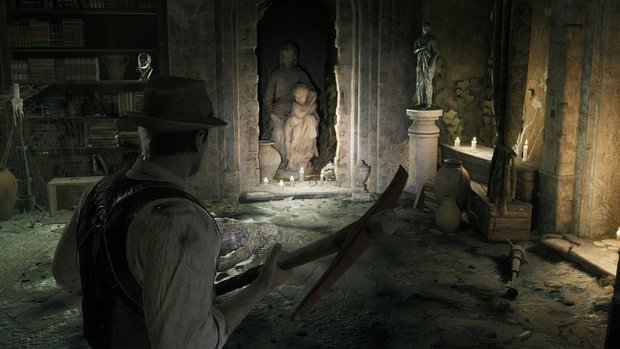
- 0 Comments
Only the combat misfires in an otherwise impressive modern re-imagining of the seminal survival horror classic
I’m lucky enough to have been around (and of the right age) to experience the original Resident Evil when it first debuted on the Sony PlayStation. It was my first step into the world of survival horror, and it well and truly opened the floodgates for myriad other successful series in the following decades. The thing is, that was in 1996, and while it may have been my first exposure to survival horror, another game had already laid the groundwork a full four years earlier. That game was Frédérick Raynal’s legendary Alone in the Dark, which itself spawned several sequels but never reached the same commercial popularity as its more famous zombie-killing successor. Over three decades later, Pieces Interactive is taking us back to where it all began with a re-imagining of the seminal classic. It may lean a bit too heavily on a combat system that feels rough around the edges, but it packs a hefty wallop when it comes to its rich Lovecraftian atmosphere and setting.
Although no previous familiarity with the series is required to enjoy this reboot, old-school gamers will instantly recognize more than mere traces of the original’s DNA inherent here. Like that game, this one takes place in 1920s Louisiana, a little outside New Orleans city limits, in the Derceto mansion. This time, however, instead of a private residence, Derceto is a mental hospital, a sanitarium where those with the means can pay to receive psychiatric care away from prying eyes (or sequester a particularly bothersome family member from the public). Players are once again given the choice between a male or female protagonist – Edward Carnby or Emily Hartwood, portrayed by David Harbour (Stranger Things, Black Widow) and Jodie Comer (Killing Eve, Free Guy) respectively – as the two search for Emily’s uncle Jeremy, currently a patient at Derceto. Soon after the pair arrives, it becomes clear that Jeremy has gone missing, and it is up to the you to investigate the asylum’s grounds to lay bare the mystery of his disappearance.
Having dual protagonists might seem to suggest a variation in gameplay styles, like in Resident Evil where one character’s campaign came with certain perks, while the other one was essentially Hard mode. That isn’t the case here, however, since Edward and Emily’s scenarios play identically to each other. Neither has any unique abilities or equipment the other doesn’t, and both get access to the same weaponry over the course of the ten-hour narrative.
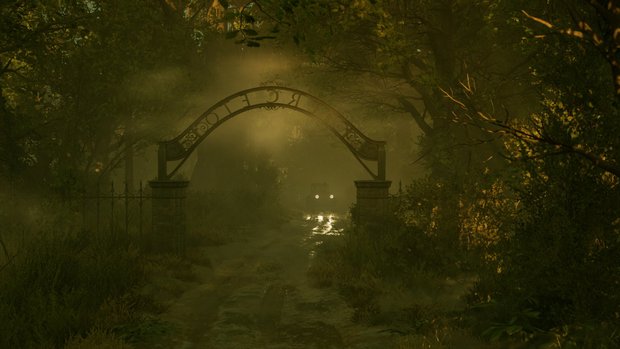
Even the story is largely the same, though individual cinematics do differ a bit. Edward and Emily will encounter the hospital’s other residents in different rooms, for example, leading to unique exchanges of dialog, though that’s just window dressing. The single important difference lies in each of the two having a unique late-game level to play through, when they’re eventually forced to confront some deep-seated internal demons before the game can move on to its climax. Even so, there’s no grand reveal to be had, no ultimate revelation from piecing together all possible facts, though Emily’s campaign does seem a tad less cryptic than Edward’s.
As for the gameplay loop, Alone in the Dark can basically be split into two major camps. In the first half of the game, Edward and Emily spend the majority of their time exploring the Derceto mansion, looking for clues, solving puzzles, and just generally savoring the atmosphere as strange occurrences begin to happen around them. After this slow-burn descent into madness, the second half sees a bigger focus on combat set pieces against the cosmic creatures you encounter, including a final boss. While both styles of gameplay bleed into each other throughout the adventure, the early hours merely see short combat sections breaking up the exploration, while after a certain point the balance shifts to the exact opposite.
On the puzzle-solving side of things, there’s a heavy emphasis on finding keys to locked doors (or otherwise getting around the mansion while certain pathways remain locked off) and figuring out combinations to safes, chests, locked drawers and the like. There are some interesting ways in which these combinations must be sussed out, and on numerous occasions I found myself consulting a handy document concerning the signs of the zodiac in my inventory. Of course, a heavy emphasis on astrology in puzzle design is no accident, tying in neatly with the overarching Lovecraftian horror evident here. In fact, I can safely say that no other game has so successfully steeped me in Lovecraftian vibes as Alone in the Dark has, while also managing to effortlessly weave in overt voodoo lore and the general Creole aura of Depression-era New Orleans. The game has a well-developed, almost tactile identity of time and place that’s admirable and immediately identifiable.

The otherworldly also gets its share of the spotlight, as Derceto is not the only setting we find ourselves exploring. Through the use of a mythical talisman (acquired very early on), you create rifts in reality that let you step through time and space, creeping through the crypts and catacombs of an overgrown New Orleans cemetery at night, braving the burning oil fields in the bayous, and combing through dockside warehouses of the fog-shrouded harbor district. But what really get the Lovecraft gears grinding are the more far-flung locales like ancient Egyptian burial tombs and glacial ice fields hiding discoveries of the more eldritch variety. I obviously won’t spoil all the surprises in store, but suffice it to say that the development team was able to really capture the thematic elements that resonate with the game's various inspirations and source materials, real-world and otherwise. Even just using the talisman involves another type of puzzle, as several rotating discs on it must be aligned in just the right way to open the next rift, with clues to the pattern concealed in the environment.
But traveling to exotic places and investigating a city as supernatural as New Orleans come with inherent dangers, and Alone in the Dark handles this by having Edward and Emily take up arms against the nightmares awaiting them. You start with a normal pistol, but later you can get your hands on a shotgun, a tommy gun, and even a flare gun to round out your arsenal. While ammunition is scarce at first (different difficulty levels affect factors like damage dealt and received and how much ammo can be scrounged up), it won’t be long before you’ll always have at least a few spare rounds on hand to get you out of sticky situations.
While the gunplay itself is neither awful nor particularly fun – pretty much point crosshairs and pull the trigger until things stop moving – it’s far from the enjoyable change of pace it might have been, and you really notice when it becomes so prominent that it pushes exploration to the periphery. For one thing, neither Edward nor Emily move fast enough to warrant such a major focus on action sequences. Neither do enemies, for that matter – they simply shamble towards you until one of you dies. What’s worse is that there are several levels full of latent atmosphere, seemingly tailor-made for exploration and puzzle-solving, which have instead been limited to just shooting bad guys.
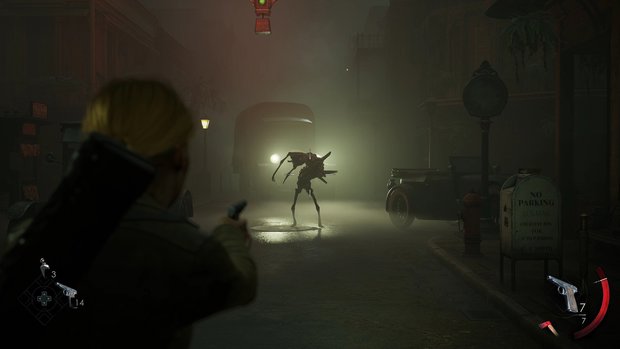
It's also possible to get more up close and personal with your foes (though not necessarily advisable, given the characters’ slow movement). You can pick up a number of melee implements, from pickaxes to sledgehammers, but getting within range of monsters tends to backfire a lot of the time, and is really only a last resort. Occasionally the game will remind you that you can also sneak to avoid patrolling enemies, but this feels so clumsy that it’s not even worth the attempt, and often ends in discovery anyway, leading to a forced (and disadvantageous) gun fight. The exception to this is Emily’s unique level, which is basically one long, albeit fairly simple and forgiving, stealth mission.
Instead of being a brawler, it’s better to play it smarter if you can. Loose bricks can be thrown to divert the attention of unaware enemies, and Molotov cocktails create flammable puddles that ignite if shot. Throwable objects are implemented in a less than ideal way, however, as you can only hold one at a time and your already slow speed reduces to an unbearable crawl when holding it. Bricks and bottles can be thrown or dropped, but not stored for later use. Regardless of the approach taken, I found myself always quietly cheering whenever a combat level ended and I got to return to Derceto to get back to the far more interesting business of exploration.
While the game conveys its themes and atmosphere superbly (and I haven’t even touched on its lore, presented via lengthy research articles, historical documents, diary entries, and letters, all fantastically voiced), the actual search for the missing Jeremy Hartwood comes up a bit lacking. Oh, there’s a definite beginning, middle, and end to it, with a coherent throughline of events, but I found it rather difficult to buy into the story, or to invest any effort into trying to figure out what was real and what was pure psychosis.

Even a full second playthrough was no help in this regard, as playing the game with the other protagonist fleshes out their particular character a bit better, but the narrative presents largely the same beats, the same unanswered questions. To be sure, the script is well-written, and the nods to the original game are plentiful and fun to discover. But these pluses don’t add up to enough reason to play the game a second time, which is a shame given the effort taken to flesh out each character better.
After so many years, the horror scene isn’t quite the same as it was in 1992, and while Alone in the Dark does a fabulous job of emulating the vibes of the original, I hesitate to actually call it scary. It’s more a suspenseful, atmospheric build-up of dread, though some locations can get the heart racing a bit. It’s worth noting that the design team chose to do away with the fixed camera angles (except for one particular scene where it’s brought back not only as an Easter Egg but actually used for a puzzle solution).
Little visual flourishes amp up the tension. As you progress, the time of day gets later and later, and the light streaming in through Derceto’s windows grows duskier until you find yourself in the middle of a dark and stormy night as the climax approaches. Disquieting set design within the manor does its part as well, like a full-size stuffed bear in the lobby that I kept expecting to be used in some sort of jump scare, or a gallery of disturbing, otherworldly sculptures overseeing the second-floor landing. And, of course, no one ever enjoys going down into the basement…
But it’s not all thrills and chills. There is ample beauty to behold, and lots of effort put into making sure it shows. Every Derceto staff member and patient has their own room, all meticulously detailed with paraphernalia that perfectly informs their character. The game’s dual protagonists have been brought to life both in both recognizable image likenesses and professional vocal performances. David Harbour’s Carnby in particular is an example of spot-on casting, as he perfectly embodies the downtrodden gumshoe. Sound effects and the movie-like soundtrack also excel, as do the various supporting cast and voice-over artists that narrate each document picked up in-game, often with a full southern drawl or the distinct Louisiana Creole patois of the area.
Final Verdict
I consider myself to have a pretty solid horror gaming background, and yet I still had a sizable Alone in the Dark-shaped gap I’ve been waiting to fill for decades. That in itself was enough reason to give Pieces Interactive’s reboot a shot, but as remakes or re-imaginings go, the game largely proves itself worthy of its considerable pedigree, creating an unforgettable sense of time and place, with mood and atmosphere to spare. Not only is it a solid game on its own merits, but it’s one of the best representations of Lovecraftian horror full stop. While its combat system and narrative may not have hit it out of the park this go-round, they still contribute to a very good, borderline great overall experience. It certainly isn’t groundbreaking like its pioneering predecessor, but in the end, the game’s pros far outweigh its cons, marking a new entry point for the franchise and offering a more modern way for newcomers to experience this seminal classic.
Hot take
Not all aspects bridge the decades-long gap seamlessly, but as a modern re-imagining, Alone in the Dark is at once a comprehensive love letter to the venerated original and hands-down one of the best forays into Lovecraftian horror yet.
Pros
- One of the best video game takes on Lovecraftian cosmic horror
- 1920s Louisiana has never felt so real
- Exploring Derceto and unearthing lore is a delicious treat
- Both protagonists get unique late-game levels that flesh them out
- Great acting from the main cast and supporting roles alike
Cons
- Not enough incentive for a full second playthrough
- Combat is at best unfun, at worst a slog that receives more emphasis than is necessary
Pascal played Alone in the Dark on PlayStation 5 using a review code provided by the game's publisher.







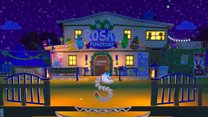

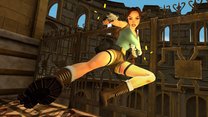
0 Comments
Want to join the discussion? Leave a comment as guest, sign in or register.
Leave a comment